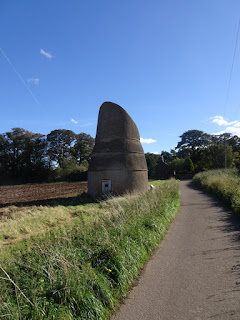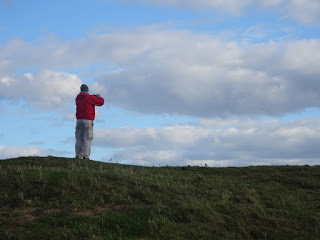As a brief update to my earlier blog, we ended up arriving much later than anticipated, so I quickly re-evaluated our plans, and after we picked up our rental car, we headed out to Preston Mill in Easton Linton.
Traffic was a bit heavy due to the time of day, but within half an hour, we found ourselves driving along the narrow streets of this charming village.
After arriving a few hours later than scheduled, we decided to reevalate the plans for the day, and we headed right out to Preston Mill in East Linton, which is actually East of the airport.
Just on the outskirts is a National Trust site, Preston Mill, which is actually one of the oldest oat grinding mills in Scotland. Pulling into the parking lot, I was awed at the picturesque view that was in front of us.
Believe it or not, the sun was shining so brightly, that it was difficult to capture a decent photo from this angle, but I’m not complaining! Here’s a view from the opposite direction.
How is that for amazing? Picture perfect, I’d say.
We were immediately greeted by three very friendly NTS attendants, one, named John, who was chosen to be our extremely entertaining tour guide of the mill.
He was pretty much the expert on the place, as he had grown up in the village and had spent many a day tormenting the last owner.
But he was very knowledgable about the place, and he went through great detail in describing the various stages involved in turning oats into the ground product.
Oats has been ground in this facility, since the 1700’s, and, actually, the mill is still operational, but was not working due to a bad bearing that needs to be replaced. So, on any other given day, one would be able to actually participate in the grinding of the oat, but this is only for demonstration purposes. The oat product is not sold for consumption.
We learned that there are three different consistencies that are produced: fine for oat cakes, medium for porridge and course for grist. All three types have been in production from the start.
The structure of the drying room is unique, in that it is shaped like a hop house that one might see in Kent, and the roof is made of imported tiles that came from the Netherlands.
Due to the close proximity to the North sea, many of the buildings in this area have that same type of red tile on the roofs of the buildings, as it was quite easy to obtain from across the sea.
However, that same distance to the sea results in frequent flooding, and the building was actually marked in several spots, with the height of the water due to floods that occurred in particular years, the last being as recent as 2017. This stone shows the levels in 1990 and 1992.
The grinding process was fairly simple, but, obviously quite a bit of hard work as much of the transfer of the materials was done by hand. Coke was used to fire the furnace in the dryer.
Then, the dried product was ground in the stones, that are turned by the water that runs through this wheel along the side of the mill.
Really, quite a fascinating process to see close up.
For you Outlander fans out there, this very same mill was the one that was used in the scene where Jamie hides from the red coats by dunking himself in the water, only to have his kilt torn off by the circulating wheel.
According to John, that water is extremely brisk, and he had quite the chuckle in the retelling of the story and the resulting firigid actor.
After we completed the tour, we were encouraged to walk over to see the “Doocot” that is accessible for viewing across the field from the mill. John felt the need to clarify that “Doocot’ is actually the Scottish word for Dovecot, a building that was built for the doves to nest in that actually provided meat and eggs for the locals.
We set out along the trail to the bridge in the distance, but not before Marty got side tracked by the fish ladder that John had mentioned during our tour.
Unfortunately….there were no fish a jumpin’.
So, we crossed the bridge, and headed down the lane to the doocot, with the village in close distance.
We spotted a few doves hanging out on the roof as we got closer, but they flew off quickly upon our approach.
We headed back to our car, and Marty took one last picture with me in front of the mill.
Then we headed to the village for a bite to eat, then began the trip along the coast with the destination of St. Abbs head. I had planned a brief stop in Cockburnspath as I had read about a Mercat cross that was given to the village by James IV in celebration of his nuptials to Margaret Tudor.
The cross stands right in the middle of the village, with St. Helen’s church directly across, dating from the 1500’s.
The book that I referenced stated that the cross stood at the end of the Upland way, which is a walking trail in Scotland, and if one walked along the way for a brief distance, one would come to a cove where, upon popping through, a picturesque town would be presented.
Well, we couldn't find anything that indicated that there was any type of path to follow, and definitely nothing that said "Upland Way" . So, I popped into the general store and asked the man in the store if he could direct me. He told me that the cross was, indeed, the end, but I needed to go to the end of the road, make a left at the garage, and the path would be on the right.
So, we did just that, but let me just mention that this was NOT just a brief distance as the book indicated. And, we never did find the cove, despite hiking along quite a distance before deciding to turn around to go back to the car. At this point, Marty decided that we would drive along the coastal trail in hopes of finding this picturesque view.
We found ourselves on a road that was just about as wide as our car, heading up a steep hill, when I finally spotted the upland way, pretty far from the village. There were wooden steps heading to the top of a cliff, but we couldn’t stop anywhere to check it out. We drove to the top of the crest, anticipating a breathtaking view as we rounded the corner, only to see a very large trailer park nestled among the cliffs below. NOT exactly what we had been looking for.
When we got to the bottom of the cliff, there was a sign that said “Ford”, and there in front of us, was the road, literally sitting in the middle of a stream. Luckily, Marty had rented an SUV, so he had no issues driving through, although I will mention that I breathed a sigh of relief when we got to the other side!
Our travels then took us back up the hill and over to the NTS sanctuary on St. Abbs, which was our intended destination.
We parked in the lot and headed to the trail.
I had presumed that we would be walking up that hill, and was a bit surprised when the arrow pointed left and we found ourselves walking along a stone wall. Didn’t see much of a view opportunity there!
But, once at the end and through the turnstile, it was obvious that we were at the right spot. As you can see, the views were spectacular!
Of course, Marty had to climb the hill to find an even better view, although I'm not convinced that it really was.
Honestly, with the weather so perfect, we could have stayed much longer, but we had an hour’s drive to our B&B, so we headed back to the car and made the drive into Kelso.
Our B&B is lovely, and the owner is quite amusing. But that story is for another day!
But before I leave you, I want to share one of John’s (from the mill) musings:
One day, a young miss was going out with a Highlander. She asked him, “Is anything worn under that kilt?” His reply was, “No worries, lass, everything is in proper working order”.
And on that note….I’ve got to get out and enjoy yet another beautiful day!




























No comments:
Post a Comment